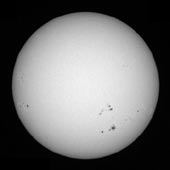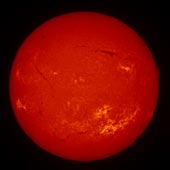
|
Seen with the human eye, the Sun appears
as an intensely bright object in the sky. The light it emits
appears to be white although if we shine sunlight through
a prism we see a continous rainbow of colors. These colors
make up the visible white light of the Sun.
Visible light makes up a very small portion of the electromagnetic
spectrum. With special equipment, it's possible to examine
the Sun in wavelengths other than visible light. Scientists
take "pictures" of the Sun as it appears in infrared,
ultraviolet, and even x-ray wavelengths. Obviously, we can't
see these non-visible portions of the spectrum. However, sophisticated
instruments can detect these wave lengths which are then converted
into images we can see. You'll notice the Sun looks different
when viewed through the "eyes" of these instruments.
Scientists use these different images to better understand
the features and the workings of the Sun.
|
|
|
Soft
x-ray image of the Sun. Taken on September 13, 2001 by the Yohkoh
Spacecraft. (Click for a larger image.) |

|
Extreme Ultraviolet
image of the Sun. Taken on September 13, 2001 by the Extreme
ultraviolet Imaging Telescope aboard the SOHO Spacecraft. (Click
for a larger image.) |

|
White-light image of the Sun.
Taken on September 13, 2001 by the Big Bear Observatory. (Click
for a larger image.) |

|
H-alpha image of the Sun. Taken
on September 13, 2001 by the Big Bear Observatory. (Click
for a larger image.) |
 See
today's images of the Sun at the Solar
Max 2000 Web site.
See
today's images of the Sun at the Solar
Max 2000 Web site. |
|

 |
 |
 |
Related
to chapter 2 in the print guide. |
 |
|
 |
|
|
 |
 |
|
|
| |
|
 |